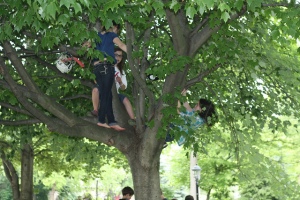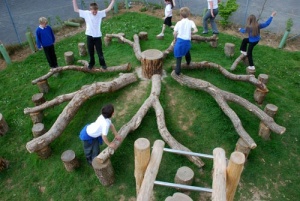Following up on my notion that we need to develop a “pattern language” for play settings I am making a list of blogs that can make contributions to that end. This is my first installment and they represent the sites that are “top of mind” for me. Where possible I have provided a link to a specific post in each blog that seems relevant. These are in no particular order and are not meant to be a review of the entire blog.
One of my gripes about playground designs is that they are almost totally devoted to active play. The Playground Pattern Language should list all the recognized types and put forward the idea that they should all be included.
Here’s a great list: Types of Play
I’ve previously mentioned Paige Johnson’s blog Playscapes. She is a strong advocate of using pathways for play rather than separators.
When playgrounds fail to engage kids, parents are forced to take matters into their own hands. I’m a big fan of Angie Six’s blog The Risky Kids. Here’s a post about the value of climbing trees:
One way to “publish” the Playground Pattern Language is as a Pinterest. Here’s a wonderful example of a company doing “natural” playscapes:




Jay, I’m so honored to be on your list! You’re an inspiration to me, and many other parents.
LikeLike
https://www.facebook.com/notes/svane-frode/overview-facebook-albums-berlin/525837970761884
https://www.facebook.com/notes/svane-frode/my-facebook-albums-overview/515934358418912
All the best!
Frode Svane
LikeLike
On the Balancing Safety LinkedIn group you also left these links:
Thank You!
BRING MORE NATURAL ELEMENTS INTO THE PLAYGROUNDS!
https://www.facebook.com/notes/svane-frode/bring-more-natural-elements-into-the-playgrounds/533162093362805
LIFE IN THE BUSHES (FACEBOOK NOTE):
https://www.facebook.com/note.php?note_id=291542447524772
BRING NATURE BACK TO CITY CHILDREN! (FACEBOOK ALBUM):
https://www.facebook.com/svane.frode/media_set?set=a.101378039924114.1614.100001557546378&type=3
LIFE IN THE BUSHES (FACEBOOK ALBUM): https://www.facebook.com/media/set/?set=a.435381543190427.99590.100001557546378&type=3
ADVENTURE PLAY – CONSTRUCTION PLAY (FACEBOOK ALBUM):
https://www.facebook.com/svane.frode/media_set?set=a.107294552665796.11107.100001557546378&type=3
CHILDREN´S NATURAL DENS – HUTS – FORTS – HIDEOUTS (FACEBOOK ALBUM):
https://www.facebook.com/svane.frode/media_set?set=a.337153349679914.77931.100001557546378&type=3
By Frode Svane
LikeLike
Have you worked with Alexander’s pattern language before? I’m very curious!
Also google Bob Hughes and play types, books classification is widely used in UK.
LikeLike
He was in Berkeley and very active at the time I was doing my early playgrounds so he and the concept was a big influence. His approach was more urban planning and broader scope than mine so I didn’t use it directly.
LikeLike
Nancy Strinste has suggested adding the Natural play Spaces site – http://www.dnr.state.md.us/cin/nps/
LikeLike
And this from John LaRue:
I think all of this stuff is great….the only think I would require is a signed and notarized document on Municipal Letterhead saying its A-OK to not have transfer stations/access routes for ADA…not have resilient surfacing…and not having proper safety setbacks per USCPSC. The playground “belongs” to the Municipality…so it is their call….and I would assume there are a boatload of designers out there that do not allow full use of their creative minds due to published mandates….relax the mandates…then do freelance designs.
There is also “Product liability”…that is different than just plain liability…product liability simply makes the supplier to have certain performance measures. Something to protect the tax payers contribution towards a community project
Time to have a gathering at a national conference and have an informal round table….Mr. Beckwith – ASLA Boston…?? – I’ll buy the 1st round! 🙂
I am quite aware there are playground equipment manufacturer’s that think they make “natural playgrounds” – by painting steel uprights brown…use green plastics – then photo shop in trees, bushes, plants, etc….and call it “natural”…pathetic eh?
When I saw what Nancy shared in MD – very very cool…the only thing I would look into is ensuring the ground cover is resilient….meets ASTM 1251 for access, the play elements are properly “secured”…and, for example, the spacing between the stepping logs…are they close enough to be “functionally linked”…and yep “functionally linked” is kinda subjective…but what they have cooking in MD is very cool! nancy – do you have a 2-D overview?
Oh…and can we try to place a ban on the stuff coming in from places like Malaysia…China…and other 3rd world countries….tell me…is it “natural” to import?
Good stuff Mr. Beckwith…food for thought…
By John Larue
LikeLike
I totally agree we need to include all different kinds of play in playground design. The local council just built a playground in my street – no consultation – they thought they were doing great shakes BUT it took over all the space where the kids were playing ball almost every day. Now they have to play ball on the road. Thanks for the include,
LikeLike